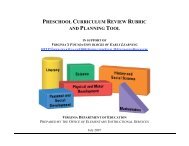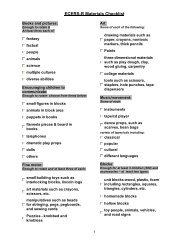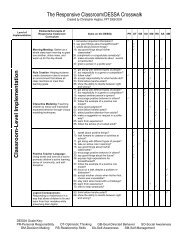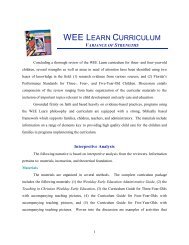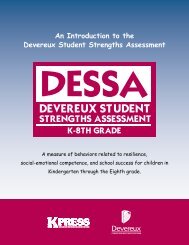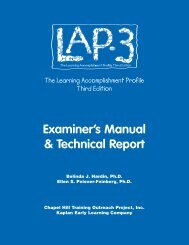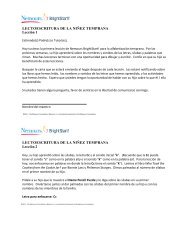Prior to selection of the criterion measures, the researchers consulted the publishers of eachassessment for re<strong>com</strong>mendations on which versions of both English and Spanish measures wouldbe most appropriate in this study. In all instances, those re<strong>com</strong>mendations were followed. Thefollowing information describes the assessments selected and their uses in this study.Developmental Indicators for the Assessment of Learning, Third Edition (DIAL-3)The DIAL-3 (Mardell-Czudnowski, C. & Goldenberg, D. S., 1998) is a norm-referencedscreening instrument that assesses child development in the following areas: Motor, Concepts,Language, Self-Help, and Social. The Motor Concepts and Language scales were used in thepresent study because the Self-Help and Social <strong>com</strong>ponents of the DIAL-3 are not normreferencedand were not used in the study. The measure is available in English and in Spanishand is appropriate for use with children from 36 to 83 months of age. The Dial-3 has goodreliability, with internal consistency coefficients ranging from .66 to .87 and test-retestcoefficients ranging from .67 to .88.Peabody Picture Vocabulary Test, Third Edition (PPVT-III)The PPVT-III (Dunn, L.M., & Dunn, L.M., 1997) is a norm-referenced instrument designed toassess receptive vocabulary from age 30 months to 90+. The measure consists of 204 itemsadministered in sets of 12 items each. The PPVT-III has excellent reliability, with internalconsistency coefficients ranging from .92 to .98 and test-retest coefficients ranging from .91 to.94.Test de Vocabulario en Imágenes Peabody (TVIP)The TVIP (Dunn, L.M., Lugo, D.E., Padilla, E.R., & Dunn, L.M., 1986) is the Spanish version ofthe Peabody Picture Vocabulary Test (PPVT-III) for use with Hispanic Americans and is basedon the PPVT-R. The TVIP is a norm-referenced instrument designed to quickly assess receptiveverbal ability from age 30 months to 18 years. Unlike the PPVT-III, the 125 items in the TVIPare administered in sequential order without sets. The measure has excellent reliability, withinternal consistency coefficients ranging from .80 to .94.Woodcock-Johnson Psycho-Educational Battery-Revised (WJ-R)The Woodcock-Johnson Psycho-Educational Battery-Revised (WJ-R) (Woodcock, R.W., &Johnson, M.B., 1989) is a norm-referenced battery of tests used to assess a range of cognitiveabilities. Three tests from the Standard Battery were used in this study. Those included Letter-Word Identification, Applied Problems, and Dictation. The WJ-R has excellent reliability andvalidity, with internal consistency coefficients averaging in the mid .90s.Batería Woodcock-Johnson-Muñoz (Batería-R)The Batería-R (Woodcock, R.W., & Muñoz-Sandoval, A.F., 1990), the Spanish version of theWJ-R, is a norm-referenced battery of tests used to assess a range of cognitive abilities in theSpanish-speaking population. Three tests from the Batería Suplementaria corresponding with the50
Letter-Word Identification, Applied Problems, and Dictations tests on the English version of theWJ-R were used in this study. The Batería-R has very good reliability, with internal consistencycoefficients ranging from the mid .80s to the high .90s.Parent QuestionnaireA parent questionnaire was distributed with the permission letters. The parent questionnairecontained basic demographic information required for participation in the study (e.g., child birthdate, gender, ethnicity), and other child background information (e.g., primary language, familyin<strong>com</strong>e, parents’ education).ProceduresA team of thirty professionals (six recruitment coordinators and 24 additional data collectors),trained and supervised by the project co-directors, recruited participants and collected the data.Each examiner had a college degree in education, developmental psychology, or another relatedfield. The examiners participated in a two-and-a-half day training session on the data collectionprocedures and administration procedures for the LAP-D, Dial-3, PPVT-III /TVIP, and WJ-R/Batería-R in the winter of 2002.A total of 2099 children participated in the study from four geographic regions across the UnitedStates. Children were recruited through contact with child care centers, Head Start, publicschools, private schools, and individual families within each of the four regions. An effort wasmade to include settings representing children from a range of socioeconomic groups. Eachprogram administrator (center director or principal), teacher, or parent in the case of homesettings, was contacted in person or by phone and recruited to participate in the study. Copies ofthe LAP-D Scoring Booklet and letters describing the study and requesting consent to participatewere shared and discussed during a subsequent meeting. In the case of child care, Head Start,and public school programs, program administrators or teachers were asked to distribute andcollect permission forms for parents interested in participating in the study. After the childrenwere recruited, each examiner was responsible for scheduling assessment visits with theappropriate individual, <strong>com</strong>pleting the assessments, and submitting <strong>com</strong>pleted protocols to theproject co-directors.When the data collection was <strong>com</strong>pleted, the individual item scores were entered into a database.Once all data had been entered, two people independently verified each item against the originalprotocol, and all errors were reconciled and corrected in the database. An analysis data set basedon the final database was programmed in SAS 8.0. Statistical analyses were generated in SAS8.0 for each <strong>com</strong>ponent of the study.Of the 2022 children in the core sample, 1960 children (93.4%) of the core sample wereadministered both the LAP-D and the PPVT-III/TVIP, either during the same testing session or intwo sessions in close proximity. In addition, 197 children (9.7%; n=85 for the English sampleand n=112 for the Spanish sample) were administered both the LAP-D and the Dial-3 and an51
- Page 3 and 4:
Initial DevelopmentDavid Wilson LeM
- Page 6 and 7:
About the AuthorsBelinda J. Hardin
- Page 8 and 9: Interpreting LAP-D Profiles........
- Page 10 and 11: validity, in English and Spanish?
- Page 12 and 13: the LAP-D Third Edition is comprise
- Page 15 and 16: Chapter 2Overview of the LAP-DThis
- Page 17 and 18: egression procedures. This study ex
- Page 19 and 20: Table 1. Subscales of the LAP-DDoma
- Page 21: LAP-D Scoring Booklet. The Scoring
- Page 24 and 25: ecomes inattentive or severely dist
- Page 26 and 27: --When borrowing a month, borrow 30
- Page 28 and 29: Determining Starting PointsOnce the
- Page 30 and 31: Scoring Procedures RulesOnce the st
- Page 32 and 33: Figure 3a. Determining the BasalJOR
- Page 34 and 35: Ceiling RulesThe child’s ceiling
- Page 36 and 37: Additional Scoring Rules1. Administ
- Page 38 and 39: Figure 5. Computing Raw ScoresDEVAG
- Page 40 and 41: complete the Scoring Summary & Prof
- Page 42 and 43: Figure 7: Shanika’s Scoring Summa
- Page 44 and 45: Figure 9: Alan’s Scoring Summary
- Page 46 and 47: Communicating Assessment Results to
- Page 48 and 49: of training and experience required
- Page 50 and 51: sessions, one to three weeks apart,
- Page 52 and 53: Changes were made to the translatio
- Page 54 and 55: 60-65 months 183 62.4 001.8 194 62.
- Page 56 and 57: Table 6. Adults and Number of Child
- Page 60 and 61: additional 409 children (19.5%; n=2
- Page 62 and 63: means, standard deviations, and cor
- Page 64 and 65: • Comprehension30-35 months 99 08
- Page 66 and 67: Table 12b. Internal Consistency of
- Page 68 and 69: Table 13b. Standard Errors of Measu
- Page 70 and 71: Test-retest reliability was determi
- Page 72 and 73: speaking children, 8.62% were Black
- Page 74 and 75: Table 17b. Means, Standard Deviatio
- Page 76 and 77: Table 18b. Zero-order Correlations
- Page 78 and 79: Table 20. Correlations Between LAP-
- Page 80 and 81: Table 23 depicts the means, standar
- Page 82 and 83: Age Equivalent ScoresAn age equival
- Page 85 and 86: ReferencesAmerican Educational Rese
- Page 87 and 88: Errata for theExaminer’s Manual &
- Page 89 and 90: Table A-1. Percentile Rank, NCE, t-
- Page 91 and 92: Table B-2. Percentile Ranks for LAP
- Page 93 and 94: Table B-4. Percentile Ranks for LAP
- Page 95 and 96: Table B-6. Percentile Ranks for LAP
- Page 97 and 98: Table B-8. Percentile Ranks for LAP
- Page 99 and 100: Table B-10. Percentile Ranks for LA
- Page 101 and 102: Table B-12. Percentile Ranks for LA
- Page 103 and 104: Table B-14. Percentile Ranks for LA
- Page 105 and 106: 30-35 MONTHS 36-41 MONTHS 42-47 MON
- Page 107 and 108: 30-35 MONTHS 36-41 MONTHS 42-47 MON
- Page 109 and 110:
Table C-1. Percentile Ranks for LAP
- Page 111 and 112:
Table C-3. Percentile Ranks for LAP
- Page 113 and 114:
Table C-5. Percentile Ranks for LAP
- Page 115 and 116:
Table C-7. Percentile Ranks for LAP
- Page 117 and 118:
Table C-9. Percentile Ranks for LAP
- Page 119 and 120:
Table C-11. Percentile Ranks for LA
- Page 121 and 122:
Table C-13. Percentile Ranks for LA
- Page 123 and 124:
Table C-15. Percentile Ranks for To
- Page 125:
Table C-16. Spanish Age Equivalents




